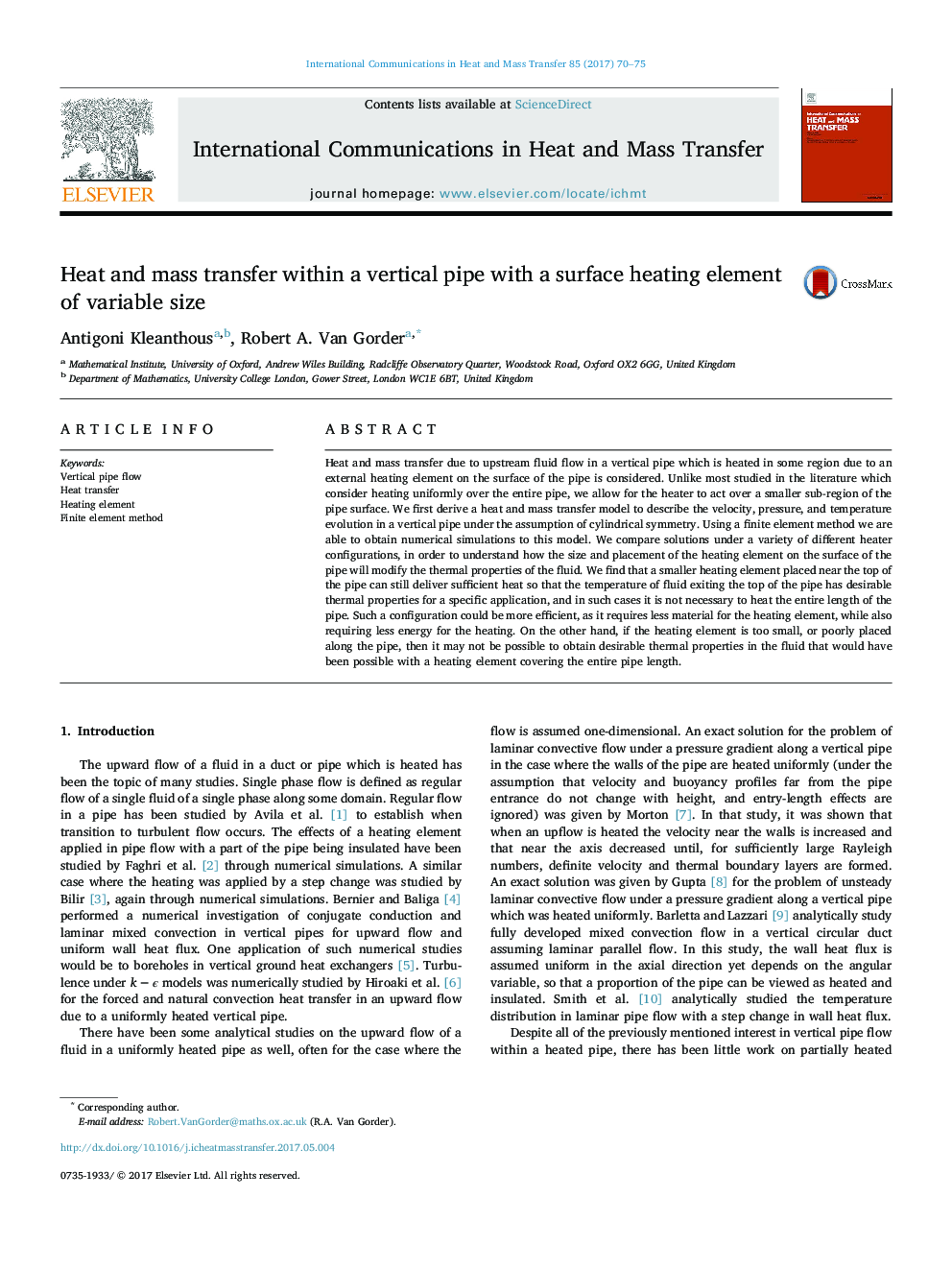| کد مقاله | کد نشریه | سال انتشار | مقاله انگلیسی | نسخه تمام متن |
|---|---|---|---|---|
| 4992886 | 1457469 | 2017 | 6 صفحه PDF | دانلود رایگان |
عنوان انگلیسی مقاله ISI
Heat and mass transfer within a vertical pipe with a surface heating element of variable size
ترجمه فارسی عنوان
انتقال گرما و جرم در یک لوله عمودی با عنصر گرمایی سطح اندازه متغیر
دانلود مقاله + سفارش ترجمه
دانلود مقاله ISI انگلیسی
رایگان برای ایرانیان
کلمات کلیدی
جریان لوله عمودی، انتقال گرما، عنصر گرمایش روش عنصر محدود
ترجمه چکیده
انتقال گرما و جرم به علت جریان مایع بالادست در یک لوله عمودی که در برخی از منطقه بوجود می آید به علت عنصر گرمای خارجی بر روی سطح لوله در نظر گرفته شده است. برخلاف اغلب مواردی که در ادبیات مورد بررسی قرار گرفته اند، گرما را به طور یکنواخت در کل لوله بررسی می کنند، ما اجازه می دهیم که بخاری را در یک منطقه کوچکتر از سطح لوله عمل کنیم. برای اولین بار یک مدل انتقال گرما و جرم برای توصیف سرعت، فشار و تکامل دمای در یک لوله عمودی با فرض تقارن استوانه ای تولید می کنیم. با استفاده از یک روش عنصر محدود، می توانیم شبیه سازی های عددی را برای این مدل به دست آوریم. ما راه حل های مختلف را با انواع تنظیم کننده های بخاری مقایسه می کنیم تا بدانیم چگونه اندازه و قرار دادن عنصر گرما روی سطح لوله باعث تغییر خواص حرارتی مایع می شود. ما دریافتیم که یک عنصر گرمای کوچکتر که در بالای لوله نصب شده است، هنوز هم می تواند گرمای کافی را ارائه کند به طوری که دمای مایع خروج از بالای لوله خواص حرارتی مطلوب برای یک کاربرد خاص است و در چنین مواردی حرارت لازم نیست کل طول لوله چنین پیکربندی می تواند کارآمدتر باشد، زیرا نیاز به مواد کمتر برای عنصر حرارت دارد، در حالی که نیاز به انرژی کمتر برای گرمایش نیز دارد. از سوی دیگر، اگر عنصر گرما بیش از حد کوچک باشد یا در طول لوله قرار نداشته باشد، ممکن است بدست آوردن خصوصیات حرارتی مطلوب در مایع که ممکن است با یک عنصر گرمایش که تمام طول لوله را پوشش داده است، امکان پذیر نباشد.
موضوعات مرتبط
مهندسی و علوم پایه
مهندسی شیمی
جریان سیال و فرایندهای انتقال
چکیده انگلیسی
Heat and mass transfer due to upstream fluid flow in a vertical pipe which is heated in some region due to an external heating element on the surface of the pipe is considered. Unlike most studied in the literature which consider heating uniformly over the entire pipe, we allow for the heater to act over a smaller sub-region of the pipe surface. We first derive a heat and mass transfer model to describe the velocity, pressure, and temperature evolution in a vertical pipe under the assumption of cylindrical symmetry. Using a finite element method we are able to obtain numerical simulations to this model. We compare solutions under a variety of different heater configurations, in order to understand how the size and placement of the heating element on the surface of the pipe will modify the thermal properties of the fluid. We find that a smaller heating element placed near the top of the pipe can still deliver sufficient heat so that the temperature of fluid exiting the top of the pipe has desirable thermal properties for a specific application, and in such cases it is not necessary to heat the entire length of the pipe. Such a configuration could be more efficient, as it requires less material for the heating element, while also requiring less energy for the heating. On the other hand, if the heating element is too small, or poorly placed along the pipe, then it may not be possible to obtain desirable thermal properties in the fluid that would have been possible with a heating element covering the entire pipe length.
ناشر
Database: Elsevier - ScienceDirect (ساینس دایرکت)
Journal: International Communications in Heat and Mass Transfer - Volume 85, July 2017, Pages 70-75
Journal: International Communications in Heat and Mass Transfer - Volume 85, July 2017, Pages 70-75
نویسندگان
Antigoni Kleanthous, Robert A. Van Gorder,
